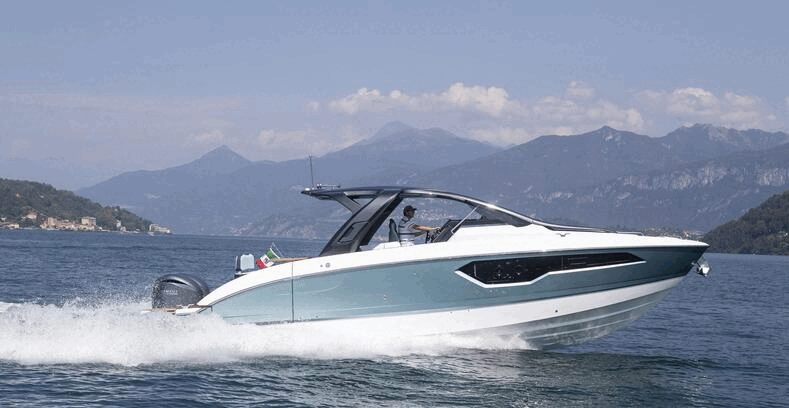Presentation
Galeon 420 Fly is the latest model launched by the Polish builder in middle last Summer and presented to the audiences in the fall 2011 boat shows. The Galeon 420 Fly sees the Strazyn boat builder with the help of designer and since 2004 collaborator Tony Castro concentrate again with a very solid release in the medium large size. Before this Galeon was concentrating in its upper sizes see 780 Crystal also launched late Spring 2011, and under the forty feet as the 385 presented last year. Initially the project and prototype where being named 400 but with an over-all length over 43 feet Galeon named this model rightly the 420 Fly. This flybridge motor cruiser has a lot an owner wants but its most desirable contents are the feeling of much bigger boat coming from the over four meters beam and thanks to a clever use of space which offers three double cabins, and living and galley on the main deck. Choice as Galeon shows in other smaller and bigger models is also a virtue for the 420 Fly coming in seven engines, three propulsion, two wood finishing options.
Accommodation
The Galeon 420 Fly is a winner when it comes to the accommodation offered, and where this is in doubt transformation give it again an advantage. The 420 Fly welcomes you aboard with a must have optional hydraulic easy tender launching bathing platform which increases length by 1.30 meters. A port side transom door takes inside the aft deck, having an L-shaped settee with central table. To port side is a built in fiberglass stair case for the flybridge, and to both sides are moulded steps which take to the well spaced side decks. A fully opening patio door which conceals by the stair case to port side, takes you to the interior saloon. Here is a C-shaped settee, and helm to starboard, while to port is an entertainment desk having a hidden TV, and galley in the one step raised forward area. A central curved stair case leads to the lower cabin deck. Genius is the astern part of the C-shaped saloon sofa moving to become a bench which joins with the settee in the aft deck to makes this area become all one.
The lower deck cabin area presents three double cabins, with two shower heads one of which en-suite for the owner and large view windows to the sides in all areas. The owners room is located to fore, and features a centre queen sized island berth, while to port is entrance to the spacious en-suite shower head. This also having a glass door separating shower stall. To midships are the guest cabins. The port side has also the option of becoming a second VIP room thanks to its optional transformation to a second double berth. Guest shower head is located to starboard.
The flybridge reached via the stair case from the aft deck offers huge spaces, with an L-shaped settee with table to aft, two units one wet bar sink, and another with grill, and two settees for four passengers with the starboard side being the one for the helm. There is also a small sun pad area in front of the passenger settee to port side. The side decks of the 420 Fly are also spacious and to fore is also two medium sized sun pads to each sides.
The lower deck cabin area presents three double cabins, with two shower heads one of which en-suite for the owner and large view windows to the sides in all areas. The owners room is located to fore, and features a centre queen sized island berth, while to port is entrance to the spacious en-suite shower head. This also having a glass door separating shower stall. To midships are the guest cabins. The port side has also the option of becoming a second VIP room thanks to its optional transformation to a second double berth. Guest shower head is located to starboard.
The flybridge reached via the stair case from the aft deck offers huge spaces, with an L-shaped settee with table to aft, two units one wet bar sink, and another with grill, and two settees for four passengers with the starboard side being the one for the helm. There is also a small sun pad area in front of the passenger settee to port side. The side decks of the 420 Fly are also spacious and to fore is also two medium sized sun pads to each sides.
Performance
The Galeon 420 Fly performance will depend on the choice you make as this model offers seven engines to choose from; Volvo four options, Cummins two, and Volkswagen. Smallest engine choice is the Volvo D4 260hp, and largest option is the Cummins QSB 5.9 at 420hp. You have also three propulsion choices from traditional shaft drive available with all, to stern drives for the Volvo engines, and IPS pod 500 only with Volvo D6 370hp. Sea trials where conducted with the Cummins 420hp, and these delivered 30.9 knots of top speed. although the props had 1.5 inch over pitching in this first test. Fast cruise was over 28 knots at 2800 rpm, drinking 72.6 liters per hour to engine. 26 knots is possible with 2600 rpm, and at 2400 you get 23 knots and a total consumption of 110 litres per hour. Another trial was conducted with the Volvo D6 370hp engines with IPS500 pods which also reached a top speed of 30 knots.
Positive
Aft cockpit deck patio, and moving settee
Three cabins plan
Interior fit out choice
Propulsion and various engine choices
Negative
Optional extended bathing platform
Aft cleats
Competition
The Galeon 420 Fly is definitely one of the best three cabins models in this size category, and also the latest. But if you are still undecided here is some other contenders you can look at. Nord West 420 Flybridge started the IPS use on a flybridge and is still regarded as one of the best handlers as at today. Other interesting choices are the Spanish Astondoa, and Rodman both launched in 2007, and the Absolute 43 Fly presented in 2010.
Absolute 43 Fly - IPS only, well sized 3 cabins, lower deck galley, modern, large view windows
Alpa 42 Fly - traditional Italian design, third cabin is option and moves galley on the main deck
Astondoa 44 Fly - shafts or IPS, three cabins only
Azimut 45 Flybridge - new 2011, cabin 3 is option and bunk, owners room is spacious
Carnevali 130 - 2003 presented, third cabin is option and bunk
Dellapasqua DC12 SL - 2 saloon plan choices, traditional Italian looks, classic Deep Vee, shafts only
Nord West 420 Flybridge - nice three cabins, good IPS handling, also available with stern drive
Rodman 44 Muse - Fulvio De Simoni design with IPS only, nice three cabins, good seller
Starfisher ST45 - flagship from this Portugal builder, IPS only, split level saloon with dining table
Storebro 435 Commander - Scandinavian looks, three cabins, shafts power
WILD CARD: Sciallino S40 Fly - traditional Italian fishing Gozzo, 2 or 3 cabins, shafts only
Conclusion
Just presented to the World wide audience the Galeon 420 Fly shows the huge progress the Polish Strazyn builder has made in recent times, setting it as a top tier European builder and being helped in this by the inspiration which Tony Castro brought seven years ago in 2004. The 420 Fly also fills a gap in the Galeon range between the 440 model and the soon to be replaced 390. Importantly this gap is filled with a product of high technical and luxury content where it sets rules for the competition to follow. Reality being that the 420 Fly is a complete flybridge motor cruiser, with a clever and spacious three cabin layout, and also offers choices to the buyer which are often unheard in this size. Choices like the seven engines, or two wood styles for the internal, go to show the upmarket prowess of the Galeon brand offering a semi custom product in thirteen meters.
Technical Data
LOA. 13.25 metres (43.4ft) with optional bathing platform
LOA - 12.2 m without extended bathing platform
Hull Length. 11.79 m
Waterline length. 10.35 m
Beam. 4.16 m
Draft. 0.80 m ex props, 1.13 m with shafts, 1.15 m with stern drives, 1.19 m with IPS pods
Displacement. 12000 kg light
Fuel Capacity. 2 x 600 l
Water Capacity. 450 l
Max Persons. 12
Accommodation. 6 berths in 3 cabins
Engines. 2 x Volvo D4 260hp, D4 300hp, D6 370hp, D6 400hp, Cummins QSD 4.2 350hp, QSB 5.9 420hp, Volkswagen TDI 265hp
Propulsion. line shaft, Volvo forward looking IPS500 dual prop pods Volvo DPH stern drive
Speed. 30 knots max with Cummins 420hp and shafts, 30 knots with Volvo 300hp stern drive, 30 knots with Volvo 370hp IPS500
Range. 185 nautical miles at 23 knots cruise
Hull Shape. modified Vee with 16 degrees dead rise aft
Project. Tony Castro
Construction. Infusion technology for hull, deck and flybridge hand laid. Orthoftalic DCPD resin.
Certification. CE B
Picture Copyright Galeon. Data Galeon.





































